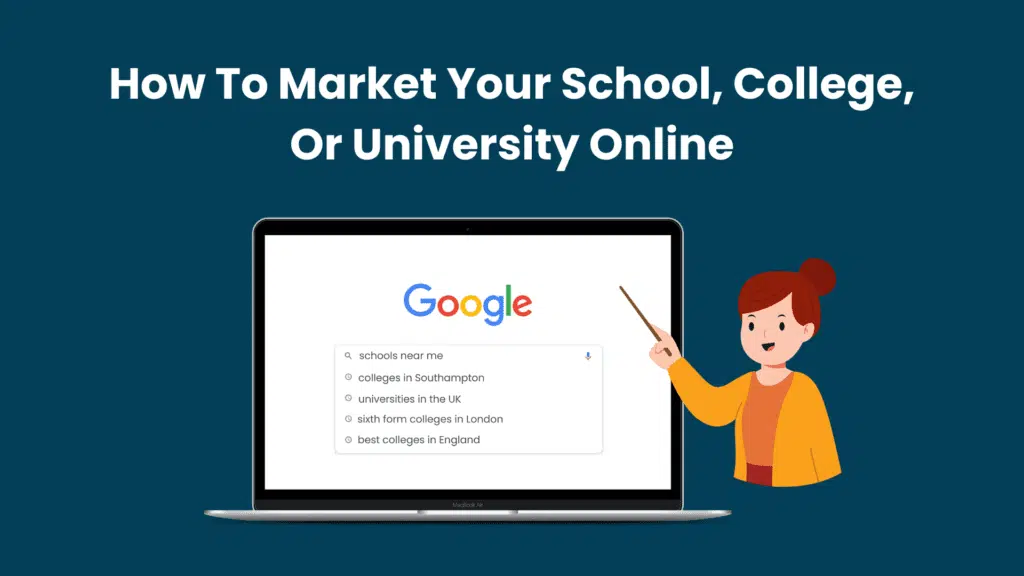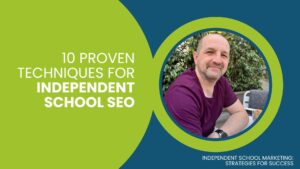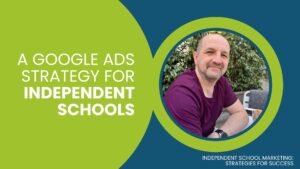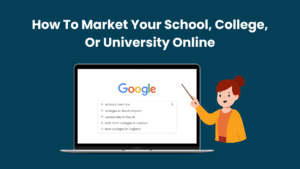The competition grows increasingly fierce for those in the education sector. Digital technology continues to break down the geographical barriers between businesses and prospective students. Schools, colleges, and universities now compete with one another on a more national, and global, scale. Therefore, if you are within this industry then you need an aggressive growth strategy, requiring a strong pipeline for new students, admissions, and a long family line of students.
Needless to say, strong and robust digital marketing strategies are needed to achieve this. Having strong branding is one thing, but it is crucial to be able to deliver a consistent stream of high-quality opportunities to your education website.
When it comes to doing this, there is an abundance of strategies you can adopt. SEO, technical SEO, PPC, social media advertising, email marketing, print media, and much more. In this blog, we’ll be outlining the most impactful strategies you can implement and our tips on how you can use them in your school marketing, college marketing, or university marketing.
Different Ways To Market Schools, Colleges, and Universities Online
There are a few different methods to advertise in the education sector, and you’ll find that in order to be there when people are searching, we recommend that you need to be taking on these methods. Whether it’s with Google Ads, Search Engine Optimisation (SEO), Conversion Rate Optimisation (CRO), Facebook Advertising or a new website, marketing online is vital in this day and age.
But to begin, let’s be sure we have the marketing funnel right and how we can exercise your marketing strategy using the journey of a new student.
Education Marketing Strategies Using Google Ads
There are numerous versions of the marketing funnel. For this strategy, let’s consider a simple, three-stage funnel.
Stage One: Awareness and Interest (Top of Funnel)
To create demand, your audience must first be aware of your school, college, or university. The goal of this first stage of the education marketing strategy is to create awareness, create interest and stimulate desire. That outcome naturally creates some sharing and chatter around your school, college, or university too, both through Social Media and in-person.
For example, a school marketing strategy promoting an open day, might target an audience of parents with ads for their next event. Your audience is not always likely to click and book straight away, but we can expect;
- The audience to share the event with friends who are also looking for schools
- The audience to consider the event over the coming days or weeks, particularly if they see ads frequently
- The audience to discuss going to the open day with their children or spouse
- The audience to search Google for more information about the event during or after those conversations
Do you have an open day to share? Here are 4 ways to advertise a school open day online.
Book a FREE Education Marketing Consultation Today
Please provide your details below and one of our specialists will be in touch as soon as possible.
We will further explain the processes of our education marketing sector services and answer any questions you have.
Stage Two: Desire
Once your audience is aware of the school, college, or university and are interested, regardless of how they came by that knowledge, they’ll want to know more about it. Where it is, how much are the tuition fees (if applicable), what age students you accept, if you’re a mixed school or a boys or girls school, college, or university. If you are specifically looking to advertise something like an open day, this information plus some more about the open day will be relevant to the audience.
For that, many will turn to Google, hunting for the school, college or university. Perhaps they’ll search for you by name if they remember, but they may also search by location with searches like ‘schools in Southampton’ or ‘universities in London’ and you will want to show when they search for that, which you can use Google Ads search campaigns to do that.
Stage Three: Conversion
Traffic from campaigns in Stage One and Stage Two is going to land on your institution’s homepage or perhaps a specific page like your Open Day page (or Facebook page, or Eventbrite page for Open Day tickets etc.).
To maximise bookings or admissions, the content on these pages is essential. This is your sales proposition, if you like. Your opportunity to sell the school, college, or university. With the propositions on your website, the Conversion Rate Optimisation is critical to the success or failure of your Education Marketing Strategy, regardless of how effective Stages One and Two are.
Conversion Rate Optimisation (also known as CRO), focuses on optimising different points on your website that increases the likelihood of someone converting and doing the desired action, like booking an open day ticket. CRO works on tweaking small and big parts of your website, and can even be down to the colour of the call-to-action button. It is a key area to focus on, because getting someone to your website can be like gold dust, now you just need to cash it in by converting them.
Now that we understand the three-stage funnel, let’s explore the opportunities to market your school, college, or university using Google Ads.
Steps to Promote Your Education Institution on Google Ads
To begin, Google Ads is a platform that allows businesses to create and run advertising campaigns on Google search and partner websites. Advertisers can create ads, select keywords, and set a budget for their campaigns. When users search for those keywords on Google, the ads can appear at the top of the search results, increasing the visibility of your school, college, or university and driving more traffic to your website. The platform uses a pay-per-click (PPC) model, meaning that advertisers only pay when someone clicks on their ad.
In order to promote on Google Ads, there are several things to think about first.
Define the audience that is most likely to be interested in your school, college, or university
Within your marketing strategy, you may have created customer personas, and these are the people that you want your ads to reach. With Google Ads, you can target locations, ages, interests, life events (like having a baby or graduating) and especially keywords and people’s searches.
By using these targeting options, you can reach your desired audience and increase the chances of your ads being seen by people who are most likely to be interested in your products or services.
Define The Features & Benefits
Using benefits and features in ad copy is an effective way to communicate the value of your products or services to potential customers. Benefits are the advantages or results that a student will experience and features are the characteristics or specifications of your school, college, or university. If you have an Olympic sized swimming pool in your university or offer wraparound care at your prep school, shout that from the top of the mountains (and the top of the results pages!).
By highlighting the benefits and features of your school, college, or university in your ad copy, you can help potential students understand why they should choose you over your competitors.
Choose the type of Google Ads which best suits your audience.
The type of Google ad matters because different ad formats serve different purposes and appeal to different audiences. For example, search ads are best for promoting the school, college, or university for searches such as ‘[education institution] in Portsmouth’, while display ads are better for creating brand awareness or an open day.
Video ads are more engaging and interactive, making them well-suited for promotions and brand building. Video ads may be really effective for your audience too, perhaps if you’re looking to target college leavers who are likely to be watching YouTube.
Display ads are a great way to encourage brand awareness too. Display ads are less likely to be clicked on due to it being an interruption to somebody’s day, which means that your budget can be stretched further (because you only pay when someone clicks, remember!) and be shown to more people. These are effective when you want to promote an open day, for example.
Get Your Personal Google Ads Audit Video
Please provide your details below and one of our specialists will be in touch as soon as possible.
Increasing Success With Google Ads
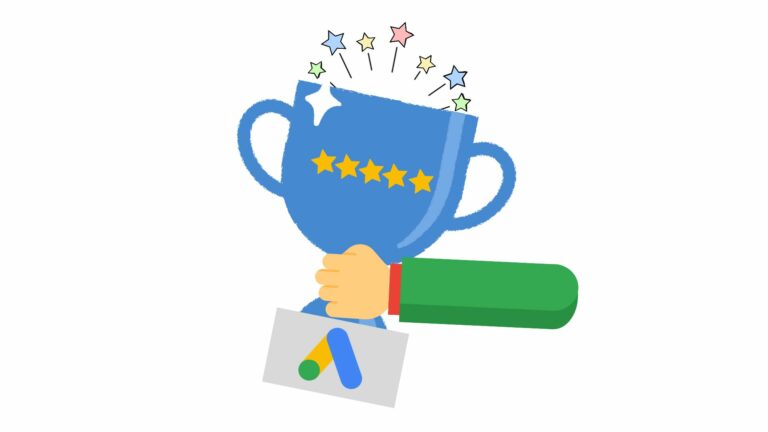
Selecting the right ad type can help improve the performance of your ad campaign, as different ad types can have different click-through rates, conversion rates, and costs-per-click. By choosing the appropriate ad format for your business or campaign, you can optimise your ad spend and achieve better results.
Ensuring that your message is reaching the people who are most likely to be interested in it, is important for choosing the right form of ad. If your target audience is primarily composed of young parents, it may be more effective to use YouTube ads if parents are often watching YouTube with their children.
Additionally, selecting the right platforms can help you to optimise your content for maximum engagement and reach. Each platform has its own set of best practices and audience expectations, so it’s essential to understand how to create content that will perform well on that platform.
Furthermore, it will help you to save time, resources, and money. By focusing on the platforms that are most effective for your audience, you can minimise your investment in less effective platforms and invest more in those that are working well.
Implement tracking to measure registrations and/or open day bookings
Implementing conversion tracking to measure registrations, open day bookings or applications is important for evaluating the success of your event marketing efforts.
One way to track registrations and bookings is to use a unique tracking link for each marketing channel or campaign. For example, if you are promoting your event on social media, email, and through a partnership with another organisation, you can create a unique landing page for each channel, with a different URL. This allows you to see which channels are driving the most registrations and bookings.
You can also track registration and bookings using web analytics tools such as Google Analytics and Google Tag Manager. With these tools, you can see how many people visited your registration or open day booking page, how long they stayed on the page, and what actions they took.
It’s worth noting that tracking the numbers is important, but it’s also important to track the quality of the applications or bookings to make sure you are reaching the right audience.
Create ads for each stage of the funnel
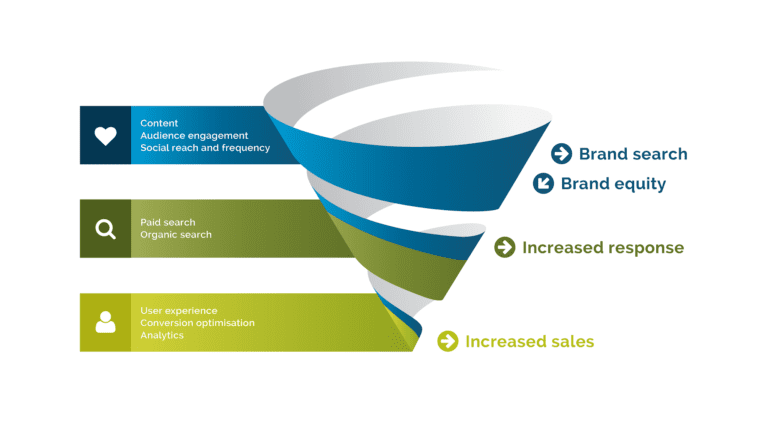
Creating ads for each stage of the funnel can help to guide potential customers through the buying process and increase the likelihood of conversion. Here are some tips for creating ads for each stage of the funnel:
- Awareness: At the awareness stage, you can use Google Display Ads to reach a large audience with broad targeting. Use eye-catching visuals and short, attention-grabbing headlines to get people’s attention. Consider using interest targeting, such as topics and placements, to reach people who are likely to be interested in your products or services.
- Interest: At the interest stage, you can use Google Search Ads to reach people who have shown an interest in your products or services. Use keywords that are specific to your product or service and include a clear value proposition in your ad copy. Consider using Google’s ad extensions, such as site links and callouts, to provide more information and drive more traffic to your website.
- Desire: At the desire stage, you can show Open Day or Book A Tour search and display ads. These ads can display images of your school, college, or university, along with driving ad copy, CTAs, right in the search results. Consider using dynamic remarketing to show personalised ads to people who have already shown an interest in your school, college, or university.
- Action: At the action stage, you can use Google Responsive Search Ads to drive conversions. Use clear, concise ad copy that emphasises the benefits of your product or service, and include a strong call-to-action to encourage people to take action. Consider using ad scheduling to show your ads at the times when people are most likely to convert.
Here are 5 reasons why your education institution should use Google Ads.
If you already have Google Ads running, request a free Google Ads audit, and we can give you some recommendations on how you can improve and optimise your campaigns.
Promoting My School, College, Or University with SEO
SEO stands for Search Engine Optimization. It’s the process of optimising a website to rank higher in search engine results, such as Google, and attract more organic traffic. SEO involves several strategies and techniques, including keyword research, on-page optimization, content creation, link building, and technical SEO, to improve a website’s ranking and visibility in search results. The goal of SEO is to make a website more attractive to search engines and improve its ranking for relevant keywords, so it appears higher in the search results and attracts more organic traffic.
Let’s go into detail about how you can optimise your school, college, or university website for Google to think ‘yes, this is relevant to this user’s search, let’s put this result right to the top!’. Higher result on the search engine results page (SERP) = higher click-through rate (CTR) = more traffic = higher chance of acquiring more students.
Keyword Research
Keyword research is a crucial aspect of SEO, as it helps determine the keywords and phrases that your target audience is searching for. The goal of keyword research is to identify keywords that have high search volume, low competition, and are relevant to your business.
To conduct keyword research, you can use tools like Google Keyword Planner, SEMrush (below), and Ahrefs. These tools will help you to do the following.
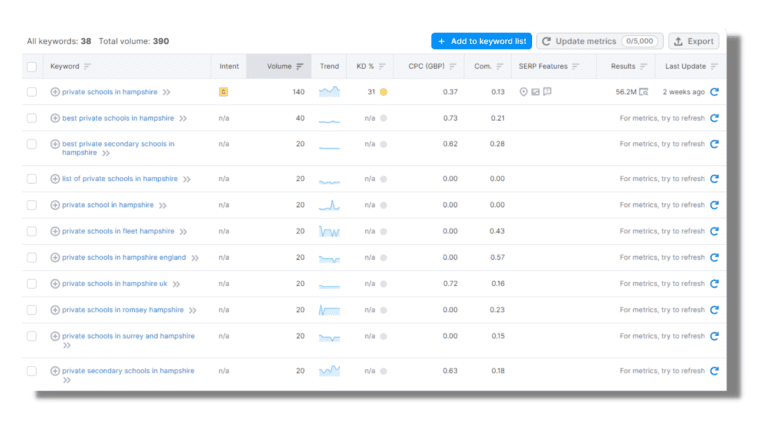
Identify Keywords
Find keywords that are relevant to your business, product or service, and target audience. Look for keywords with high search volume, low competition, and a strong relevance to your website.
Analyse Keyword Difficulty & Relevance
Determine the competition level for each keyword. The higher the competition, the harder it will be to rank for that keyword. Ensure that the keywords you’re targeting are relevant to your business, product or service, and target audience.
Group Keywords
Organise keywords into groups based on their relevance and intent. This will help you determine which keywords to target for each page on your website.
Create a Keyword List
Create a list of the keywords you want to target, along with their search volume, competition level, and relevance to your business.
By conducting keyword research, you can identify the keywords that are most relevant and valuable for your business, and target them in your SEO strategy to improve your website’s ranking and visibility in search results.
Optimising your school, college, or university website
As a school, college, or university, you want to make sure that your institution is well-represented online. One of the best ways to do this is by optimising your website for search engines.
There are some steps you can take to improve the SEO of your institution’s website and attract more potential students and their families to your site.
Meta titles and descriptions
We advise that you go through your website to begin and check that all your page titles and descriptions are optimised. Make sure your page titles and descriptions accurately describe the content of each page and include the keywords you’re targeting. This will help search engines understand what your pages are about and show them in the search results for relevant queries.
Use Header Tags
Use header tags (H1, H2, H3) to structure your content and make it easier for search engines to understand. This will improve the readability of your pages for both users and search engines.
Optimise Image Alt Text
Add descriptive alt text to images on your website to help search engines understand what they’re about. This will also improve the accessibility of your site for users with visual impairments. For an image of a group of students at a desk, the alt tag may be ‘a group of sixth form students sitting at a desk in a classroom’, for example.
Improve Site Navigation
Make sure your website is easy to navigate and provides a positive user experience. Use clear, descriptive link text and a logical site structure to help users and search engines find the information they’re looking for.
Use Schema Markup
Add schema markup to your website to help search engines understand the content and structure of your pages. This will make it easier for search engines to show your pages in the search results for relevant queries.
Create Valuable Content
Develop valuable and informative content that answers the questions potential students and their families have about your school, college, or university. Use blog posts, videos, and infographics to provide helpful information and insights.
Build Backlinks
Acquire high-quality backlinks from reputable websites and educational organisations. This will improve your website’s authority and help it rank higher in search engine results.
Monitor Your Progress
Use tools like Google Analytics and Google Search Console to monitor your school, college, or university’s website traffic, rankings, and performance. Make changes to your SEO strategy as needed to continue improving your results.
By following these steps, you can optimise your school, college, or university’s website for SEO and attract more potential students and their families to your site. By improving your website’s ranking and visibility in search engine results, you can build a stronger online presence and make it easier for people to learn about your institution.

Are your competitors consistently outranking you?
We can help you understand why and, more importantly, how to change it!
Get an SEO Review Now (Personal Video)
Conversion Rate Optimisation For Your School, College or University.
As a school, college, or university, you want to make the most of your online marketing efforts by attracting potential students and their families to your website and converting them into enrolments. Conversion Rate Optimisation (CRO) is the process of improving the percentage of visitors to your website who take a desired action, such as filling out an application, booking a tour or open event appointment or requesting more information.
Here are some things you can do to optimise your school, college, or university pages.
Define Your Conversion Goals
Determine what you want visitors to your website to do, such as filling out an application, requesting more information, or scheduling a school tour. This will help you focus your CRO efforts and measure your success.
Conduct User Research
Learn more about your website’s visitors and what they want from your institution. Use tools like surveys, heat maps, and session recordings to gain insights into their behaviour, motivations, and pain points.
Improve User Experience
Make sure your website is easy to navigate, provides a positive user experience, and meets the needs and expectations of your visitors. Use clear, concise, and engaging language and graphics to communicate your value proposition and make it easy for visitors to take action.
Test and Optimise Your Website
Use A/B testing, multivariate testing, and other optimization techniques to make changes to your website and measure the impact on your conversion rate. Test different variations of your headlines, call-to-actions, forms, and other elements to find the ones that work best for your audience. Change ‘apply now’ to ‘start your university journey today’, and see what happens to your conversion rate.
Make Use of Social Proof
Use testimonials, ratings, and reviews from current students, alumni, and other trusted sources to build credibility and trust with your visitors. This will help convince them to take action and enrol in your institution.
Offer Incentives
Provide visitors with incentives to take action, such as scholarships, financial aid, and other rewards. This will make it more attractive for them to enrol and reduce any perceived risk or hesitation.
Continuously Monitor and Improve
Regularly analyse your website’s performance and make changes to your CRO strategy as needed. Use tools like Google Analytics and heat maps to track your conversion rate, monitor your visitors’ behaviour, and identify any areas for improvement.
By following these steps, you can improve the Conversion Rate Optimization (CRO) of your school, college, or university’s website and increase your enrolment, application, and conversion rates. By making it easier for visitors to take action, you can achieve your online marketing goals and achieve success.
Sounds good, but why is digital marketing important?
Digital marketing is increasingly important for schools, colleges, and universities as it allows you to reach a wider audience, effectively communicate your unique value proposition, and ultimately, attract and enrol new students. With the rise of online education, digital marketing helps educational institutions showcase your programs, courses, and facilities to potential students.
By leveraging digital channels such as social media, Google Ads, and website optimisation, your education institution can reach a large, diverse audience and effectively communicate the benefits of your programs and initiatives.
Additionally, digital marketing provides a cost-effective and measurable way for educational institutions to promote your brand, engage with your audience, and build relationships with prospective students and their families.
In short, digital marketing is an essential tool for schools, colleges, and universities to remain competitive and achieve their enrolment goals in today’s digital age.
Here at Tillison Consulting, we provide a range of digital marketing services for a variety of different business sectors. If all of these sounds too much, we’d be pleased to help. We have increased traffic, click-through rate and enrolments for many schools in the UK, and we can bring the same success to you. Check out our other services:

